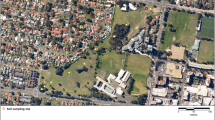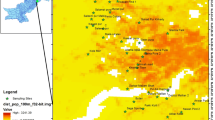Abstract
Urban roadside soils are the “recipients” of large amounts of heavy metals from a variety of sources including vehicle emissions, coal burning waste and other activities. The behavior of heavy metals in urban roadside soils depends on the occurrence as well as the total amount. Accordingly, knowledge of the interactions between heavy metals and other constituents in the soil is required to judge their environmental impact. In this study, correlations of heavy metal concentrations (Pb, Zn, Cu, Ag, Se, Ni, Cr and Ba) to iron extracted using dithionite–citrate–bicarbonate (DCB) buffer (FeDCB), fulvic acids and particle size fractions were examined from the Xuzhou urban roadside soils. Heavy metals except for Cr and fulvic acids had a positive significant correlation with FeDCB, indicating these metals and fulvic acids are principally associated with the surfaces of iron oxides of the soils. Significant positive correlations were also found between the contents of fulvic acids and heavy metals, showing these heavy metals (especially for Cu, Ni and Cr) form stable complexes with fulvic acids. Such finding is of importance with regard to the increased mobilization of heavy metals, e.g., into freshwater ecosystems. Ag, Se and Cr are independent of particle size fractions because of their low concentrations of Ag and Se in the studied soils. Pb, Zn, Cu, Ba and Ag are mainly enriched in the finer soil particles (especially <16 μm).



Similar content being viewed by others
References
Al-Chalabi AS, Hawker D (2000) Distribution of vehicular lead in roadside soils of major roads of Brisbane, Australia. Water Air Soil Pollut 118:299–310
Bolton KA, Evans LJ (1996) Cadmium adsorption capacity of selected Ontario soils. Can J Soil Sci 76:183–189
Brümmer GW (1986) Heavy metal species, mobility and availability. In: Bernhard M, Brinckman FE, Sadler PJ (eds) The importance of chemical “speciation” in environmental processes. Dahlem Konferenzen. Springer, Berlin Heidelberg New York
De Miguel D, Llamas J, Chacón E, Berg T, Larssen S, Rǿyset O, Vadset M (1997) Origin and patterns of distribution of trace elements in street dust: unleaded petrol and urban lead. Atmos Environ 31(17):2733–2740
Forstner U (1980) Trace metal analysis of polluted sediments part 1, assessment of sources and intensities. Environ Technol Lett 1:494–505
Guisquiani PL, Gigliotti G, Businelli D (1992) Mobility of heavy metals in urban waste-amended soils. J Environ Qual 21:330–335
Guisquiani PL, Concezzi L, Businelli M, Macchinoni A (1998) Fate of pig sludge liquid fraction in calcareous soil: agricultural and environmental implications. J Environ Qual 27:364–371
Hemphill CP, Ruby MV, Beck BD, Davis A (1991) The bioavailability of lead in mining wastes: physical/chemical considerations. Chem Speciat Bioavailab 3:135–148
Jardine PM, Dunnivant FM, Selim HM, McCarthy JF (1992) Comparison of models for describing the transport of dissolved organic carbon in aquifer columns. Soil Sci Soc Am J 56:393–401
Jones JM (1987) Chemical fractionation of copper, lead and zinc in ombrotrophic peat. Environ Pollut 48:131–144
Langen M, Hoberg H (1995) A description of the distribution of heavy metals in soils and sediments containing iron oxides and consequences for the decontamination process. In: van den Brinkm WJ, Bosman R, Arendt F (eds) Contaminated Soil’95, Kluwer, Amsterdam
Li ZB, Shuman LM (1997) Mchlich-1 and DTPA extractable lead in soils in relation to soil properties. Commun Soil Sci Plant Anal 28:351–363
Lin ZX, Harsbo K, Ahlgren M, Qvarfort U (1998) The source and fate of Pb in contaminated soils at the urban area of Falun in Central Sweden. Sci Total Environ 209:47–58
Navas A, Machin J (2002) Spatial distribution of heavy metals and arsenic in soils of Aragon (Northeast Spain): controlling factors and environmental implications. Appl Geochem 17:961–973
Ratha DS, Sahu BK (1993) Source and distribution of metals in urban soil of Bombay, India, using multivariate statistical techniques. Environ Geol 22:276–285
Rieuwerts JS, Thornton I, Farago ME, Ashore MR (1998) Factors influencing metal bioavailability in soils: preliminary investigations for the development of a critical loads approach for metals. Chem Speciat Bioavailab 10(2):61–75
Sutherland RA (2003) Lead in grain size fractions of road-deposited sediment. Environ Pollut 121:229–237
Tack FMG, Verloo MG, Vanmechelen L, VanRanst E (1997) Baseline concentration levels of trace elements in soils in Flanders (Belgium). Sci Total Environ 201:113–123
Turer DG, Maynard JB (2003) Heavy metal contamination in highway soils. Comparison of Corpus Christi, Texas and Cincinnati, Ohio shows organic matter is key to mobility. Clean Technol Environ Policy 4:235–245
Vermette S, Irvine KN, Drake JJ (1987) Elemental and size distribution characteristic of urban sediments, Hamilton. Can Environ Technol Lett 8:619–634
Wang XS, Qin Y, Sun SX (2005) Accumulation and sources of heavy metals in urban topsoils: a case study from the city of Xuzhou, China. Environ Geol 48:101–107
Author information
Authors and Affiliations
Corresponding author
Rights and permissions
About this article
Cite this article
Wang, XS., Qin, Y. Relationships between heavy metals and iron oxides, fulvic acids, particle size fractions in urban roadside soils. Environ Geol 52, 63–69 (2007). https://doi.org/10.1007/s00254-006-0449-0
Received:
Accepted:
Published:
Issue Date:
DOI: https://doi.org/10.1007/s00254-006-0449-0




